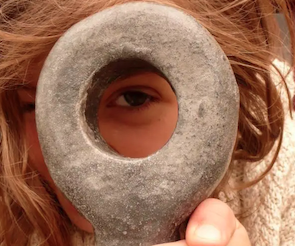Considered a modernist movement in music, emerging around the 1940s, Musique contrète is a type of composition using recordings as raw material, which are then manipulated and edited. It can consist of recordings of voices, instruments, your environment and/or electronic/mechanical sounds, instead of relying solely on instruments to create the music. Musique concrète is composed directly from the recorded sounds- which is where it gets the term ‘concrete’ from, as the sound exists in the physical world, (unlike musical notes). The genre emerged from the new music technology developed in the post war era.
Once recorded the sound can be manipulated in various ways to create the desired effect, these can included; cutting the tape by hand, speed changes, reversing the sound, looping, distortion and filtering. As a result the composition usually appears as a kind of sound collage, combining and layering many different sounds with many different effects- often in a non traditional form.
Pierre Schaeffer, a french composer, writer, broadcaster and engineer was one of the core developers of musique concrète, in 1948, he began experimenting with phonographs and tape recorders to manipulate sound. In 1951 he formed ‘Groupe de Recherche de Musique Concrète’ which was a center for research, experimentation, and production of musique concrète. It was a place where composers and engineers could collaborate on creating music using tape recorders, sound manipulation, and electronic equipment. One of Schaeffer’s earliest musique concrète compositions was “Étude aux chemins de fer” 1948, using recordings of train sounds. Pierre Henry was another early artist working with musique concrète, his most known piece “Symphonie pour un homme seul” (1949–1950) was a collaboration with Schaeffer, combining various sounds; vocal fragments, whistles, footsteps, doors slamming & metallic sounds to create the narrative.
“Symphonie pour un homme seul”
It’s the lack of structure, the embrace of experimentation and overall rejection of traditional music that makes musique concrete modernism. Wanting to use technology to create something entirely new, soundscapes became abstract and experimenting was welcomed, which pre-war would have been met with, most likely, a lot of skepticism. This is due to the culture of both music and the arts in general being both very classical and traditional, generally, people’s tastes were much more conservative and so the arts was expected to follow these societal norms. Aswell, early technology of the 1940s was just starting to become popular and musique concrete chose to embody this technology which completely changed the sonic practices of society. Although at first it was a small population of artists who’s practice it changed, the rates at which it grew and inspired other artists and movements of modernism was vast.
Although founded in the 1940s, musique concrète is still relevant and used today by many sound artists and musicians as it lay a groundwork for sound design and sampling. When looking into how it is involved in contemporary practices, I chose to look into jazz and soul artists who have used techniques of musique concrète. Musicians such as Herbie Hancock, Sun Ra, Madlib and Alice Coltrane all use techniques reminiscent of Musique concrète. Each use samples and sound manipulation in their own way, to create their own unique sound but which all stem from the process of Musique concrète.
Below is Herbie Hancocks album Sextant (1973) which features electronic sounds and synthesized effects that use techniques of musique concrète, including the manipulation of recorded sound textures.
The reason I chose to research Musique concrète and look into how these typically jazz and soul artists have used Musique concrète techniques in their work is because my current practice is more catered to creating music rather than sound art installations or other pieces of artwork. And so I wanted to look into a historic practice that is most relevant to what I want to create, especially within the genres of music I work in ( soul and jazz). From my research I not only feel more comfortable in my choice of course ( as I know I can relate what I learn into my practice) but am also more insightful into how the introduction of technology drastically changed the sound and music world, in my opinion, for the better.
